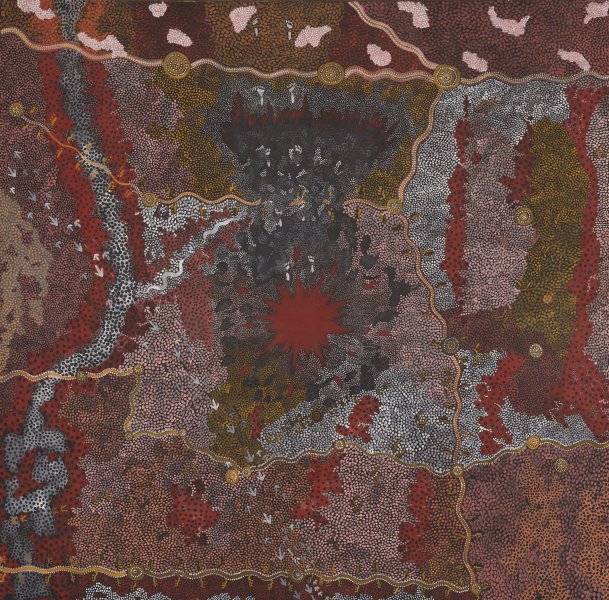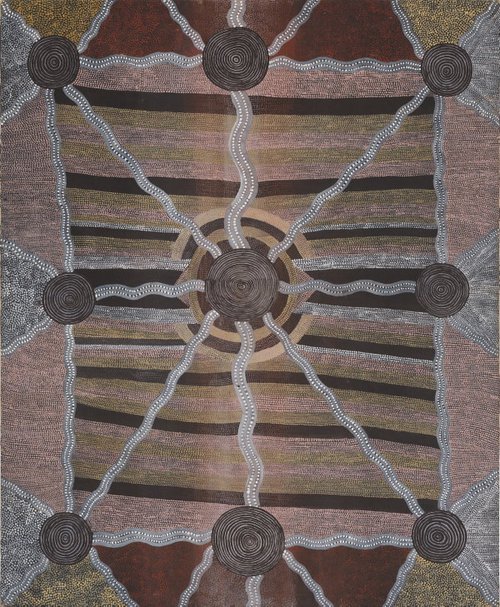Title
Warlugulong
1976
Artists
Clifford Possum Tjapaltjarri
Australia
circa 1932 – 21 Jun 2002
Language group: Anmatyerr, Central Desert region
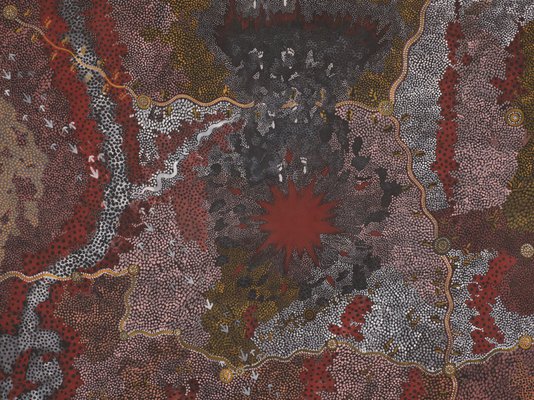

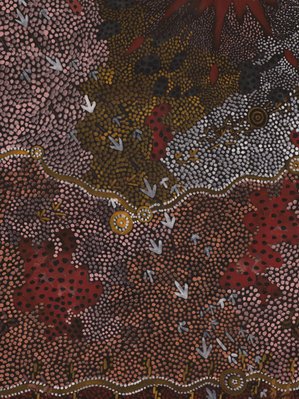
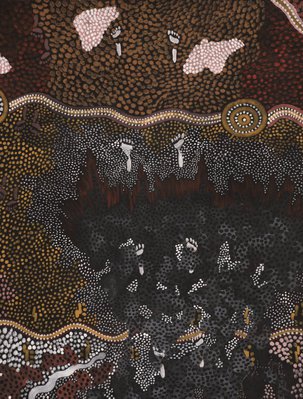
-
Details
- Place where the work was made
-
Papunya
→
Northern Territory
→
Australia
- Date
- 1976
- Media category
- Painting
- Materials used
- synthetic polymer paint on canvas
- Dimensions
- 168.5 x 170.5 cm stretcher
- Signature & date
Not signed. Not dated.
- Credit
- Purchased 1981
- Location
- North Building, ground level, Yiribana Gallery
- Accession number
- 321.1981
- Copyright
- © Estate of the artists. Licensed by Aboriginal Artists Agency Ltd
- Artist information
-
Clifford Possum Tjapaltjarri
Works in the collection
- Artist information
-
Tim Leura Tjapaltjarri
Works in the collection
- Share
-
-
About
This painting is a masterful collection highlight, but it is also a digest of the artist's customary law of the Central Desert region, made by two brothers who were among the first to experiment with transposing ceremonial body- and ground-painting designs to canvas.
Warlugulong is the site where the great fire began.
Lungkata, the blue-tongue lizard man, had rested at this site. His two sons, following behind, speared a kangaroo, cooked it, and then greedily ate it all. The father, wondering why his sons were so long, suddenly sensed what had happened. Determined to punish them, he blew on a fire-stick until it glowed, then touched it to a bush. The bush exploded into flame (as the painting illustrates), then burnt everything in its path. Tongues of flame flicked out, as do all lizards' and snakes' tongues to the present day, and soon the two brothers were fighting the flames.
They broke branches and beat at the fire, but always the front leapt beyond them, forcing them back, as the tracks indicate. Far to the south they perished, going into the ground as the bushfire lost its fury and died.
Lungkata and his two sons reside at the site where the fire began, nearly 300 kilometres north-west of Alice Springs.
All mythological events are 'larger-than-life' - more intense, more devastating, more uplifting, more heroic - and yet are related to it. Just as the bushfire was so devastating, so the dreamtime storms were all derived from a 'storm to end all storms'. The trail which begins on the uppermost edge of the painting shows how the Rain Dreaming came from Kalipinypa, far to the west. Here the wind blew, the dust clouds scurried and billowed, and then the lightning man, 'boss' of the storm, struck. He lashed the storm into a furious deluge. The rain poured down, running over the ground, filling the rockholes, flowing out until it formed a creek and a sheet of water flowing over the earth. And then the storm travelled east, creating more claypans and rockholes on its way.
Near Kerrinyarra, a large mountain 240 kilometres north-west of Alice Springs, a long line of claypans runs, fringed by tea-tree scrub and sandy country. This country, home of an enormous snake, is depicted on the left-hand side of the painting. When the great rains come these claypans fill, and form an almost unbroken line nearly twenty kilmetres long: the mythological snake is believed to have stirred, and may lurk in the waters ready to attack those who do not respect his power.
Two carpet snakes are depicted as travelling north from this 'lake', and yet another pair of carpet-snake men travelled on the lower route which traverses the entire painting. Coming from the vicinity of Hooker Creek (Lajamanu), some 1000 or so kilometres north-west of Alice Springs, they travelled the country, calling people together at various places to instruct them in the performance of ceremonies. Each small set of concentric circles marks a place where the ceremonies were held, an identifiable location to the present day as with all such sites depicted in the painting - Nyamala-ungar-angutja, Yunkurru, Takarilla-buntja, Arrungaputa, Takara, Aruakuna, Arrangi; the place names run from the north to the south over a vast stretch of country.
Similarly, the uppermost transverse route is that of Yarapiri, an enormous snake who, travelling from Winparrku (a sacred mountain over 300 road kilometres to the west of Alice Springs), made many features of the present landscape as he travelled north into the Tanami Desert, far to the north-west of Alice Springs. The white blotches near the edge of the painting indicate that he passed through limestone country.
Mythological storms such as that which began at Kalipinypa are usually associated with water-birds at the claypan 'lakes' and rockholes, regrowth of plants and therefore of vegetable foods, and activity by mythological people and animals. Thus two women of the Napanangka subsection (each shown by one footprint) are indicated as travelling from Pikilyi (approximately 380 kilometres north-west of Alice Springs) in a southerly direction; these women were dancing, celebrating the prolific fruit and vegetable foods, and from far in the east, in the vicinity of Aileron (near Alice Springs), other women came. The sets of footprints are shown to the left-hand sides of the painting, their moves towards convergence showing that later they met and held women's ceremonies which were very happy ones.
The availability of grass and plant-foods is implicit in at least two other aspects of the painting.
The line of sites on the right-hand side of the painting (unlike most, they are not depicted as linked) show the route of a terrified euro (hill-dwelling 'cousin' of the kangaroo) as he was chased by a wedge-tailed eagle. The euro, browsing on grass in the Aileron area, suddenly became aware of a great eagle. He fled from hill to hill, seeking sanctuary among the rocks, but the huge wedge-tailed bird was relentless in pursuit. Eventually, at Wakulpa - where a set of talons is depicted in the painting - the eagle swept down. His talons struck and the great beak tore, and the euro was killed. After he had fed, the eagle flew on to the west, forever ready to sweep down and to rend and tear.
Conversely, the long set of emy tracks indicates a friendlier relationship. Here is shown the travelling of an emu ancestor from Yaliyumu, a site in the heart of Anmatyerre country where soakage waters and food are readily available. He travelled west into Warlpiri tribal territory, there meeting a large group of other emus. These he invited and encouraged back to the Yaliyumu area, thus establishing the good emu country that exists to the present day.
Interestingly enough, this is the one element of the painting over which the two Tjapaltjarri artist brothers have no direct authority. However, perceiving a need for some further mythological element to give even greater balance to the canvas, they asked permission of two Tjampitjinpa subsection brothers to depict part of a mythological trail over which they had ownership rights. The Tjampitjinpa men agreed, and so a further travelling route was added. Finally, one has the mythological trails of the possum men - a large route somewhat like a U resting on its side - and the mala (hare-wallaby) men. The mala men came from far in the south, from sandy spinifex country. Travelling through Kambakapiti, a gap in a range some 200 kilometres north-west of Alice Springs, they came to Kutupa, a small black hill; here they drank at a large rockhole.
Passing on they came to Yalkuti, where they suddenly came face-to-face with the possum men. Here they had a big fight, the northern possum men using karli (boomerangs) to devastating effect, while the mala only had kulata (spears).
Such a fight may well reflect that a battle did take place in the area long, long ago. Certainly it is an interesting fact that the Pitjantjatjara people, far to the south in the vicinity of the South Australia - Northern Territory border, did not traditionally make boomerangs.
This is a brief summation of the basic mythological events depicted in this very complex painting. As can be seen, not only are natural features of the landscape explained, but the stories tell of natural phenomena such as storms and bushfires; may well have a moral base; and indicate social relationships, and so on. Furthermore, although derived from the men's secret-sacred religious world, the painting is an adaptation from this realm, deliberately manipulated to allow for general viewing while also keeping faith with tribal law.
'Papunya Tula: Genesis and Genius', exhibition catalogue, Art Gallery of New South Wales, 2000
-
Places
Where the work was made
Papunya
-
Exhibition history
Shown in 14 exhibitions
Australian Perspecta 1981, Art Gallery of New South Wales, Sydney, 29 May 1981–21 Jun 1981
Patrick White's choice, Art Gallery of New South Wales, Sydney, 22 Dec 1981–31 Jan 1982
Project 41: The mosaic -The grid (1983), Art Gallery of New South Wales, Sydney, 25 Mar 1983–24 Apr 1983
Art Treasures of Olympic Cities, Lausanne Olympic Museum, , 22 Jun 1993–03 Oct 1993
Australian Collection Focus: Warlugulong 1976, Art Gallery of New South Wales, Sydney, 01 May 1999–27 Jul 1999
Papunya Tula: Genesis and Genius, Art Gallery of New South Wales, Sydney, 18 Aug 2000–12 Nov 2000
Postmark Post Mabo, Post Master Gallery, Melbourne, 29 Jun 2002–29 Sep 2002
Clifford Possum Tjapaltjarri Retrospective, Art Gallery of South Australia, Adelaide, 31 Oct 2003–26 Jan 2004
Clifford Possum Tjapaltjarri Retrospective, Ian Potter Centre: NGV Australia, Melbourne, 23 Mar 2004–03 May 2004
Clifford Possum Tjapaltjarri Retrospective, Art Gallery of New South Wales, Sydney, 14 May 2004–18 Jul 2004
Clifford Possum Tjapaltjarri Retrospective, Queensland Art Gallery, South Brisbane, 07 Aug 2004–24 Oct 2004
One sun, one moon, Art Gallery of New South Wales, Sydney, 03 Jul 2007–02 Dec 2007
Open Air: Portraits in the landscape, National Portrait Gallery [Parliamentary Zone], Canberra, 04 Dec 2008–01 Mar 2009
Remembering Forward: An Exhibition of Major Australian Indigenous Artists, Museum Ludwig, Cologne, Germany, 20 Nov 2010–20 Mar 2011
Tjukurrtjanu: Origins of Western Desert art, Ian Potter Centre: NGV Australia, Melbourne, 30 Sep 2011–12 Feb 2012
Tjukurrtjanu: Origins of Western Desert art, Musee du quai Branly, Paris, 09 Oct 2012–20 Jan 2013
Our spirits lie in the water, Art Gallery of New South Wales, Sydney, 15 Nov 2014–01 Nov 2015
Yiribana Gallery: opening collection display, Art Gallery of New South Wales, North Building, Sydney, 03 Dec 2022–29 May 2023
-
Bibliography
Referenced in 42 publications
-
Sigurd Bergmann, SÅ FRÄMMANDA DET LIKA: Samisk konst i ljuset av religion och globalisering, 'IX "Konst är religion": Aborigin konst och spiritualitet i Australien', pg. 281-334, Norway, 2009, 189 (colour illus.), 306 (illus.). plate no. 9.12
-
Edmund Capon AM, OBE, 10 Masterpieces of Australian Painting, Sydney, 1993, (colour illus.).
-
Edmund Capon AM, OBE, Art Gallery of New South Wales: highlights from the collection, Sydney, 2008, 34-35 (colour illus., detail), 35, 36 (colour illus.).
-
Wally Caruana and Franchesca Cubillo, Australia, 'Country: Aboriginal art', pg. 40-89, London, 2013, 68 (colour illus.). cat.no. 21
-
Jonathan Cooper (Editor), Exhibitions events - Art Gallery of New South Wales, Sydney, May 1999-Jul 1999, 10 (colour illus.).
-
Jonathan Cooper (Editor), Exhibitions events - Art Gallery of New South Wales, Sydney, Feb 1999-Mar 1999, 10 (colour illus.).
-
Hetti Perkins, Education Kit - Papunya Tula: genesis and genius, 'Anmatyerre icons', pg. 6-7, Sydney, 2000, 6, 7 (colour illus.).
-
Emily Joyce Evans, Remembering forward: Australian Aboriginal painting since 1960, 'Clifford Possum Tjapaltjarri and Tim Leura Tjapaltjarri', pg. 80-91, Cologne, 2010, 11, 19, 82 (colour illus., detail), 83 (colour illus.), 90. cat.no. 33
-
Marie Geissler, Dreaming the Land, 2022, 266-267 (colour illus.).
-
Christine Hall, World Cities - Sydney, London, 1999, 33 (colour illus.).
-
Helen Verity Hewitt, Patrick White, painter, manqué: paintings, painters and their influence on his writing, 'Patrick White's choice', pg. 114-119, Carlton, 2002, 116.
-
Bruce James, Art Gallery of New South Wales handbook, 'Australian Collection: Aboriginal and Torres Strait Islander Art', pg. 208-241, Sydney, 1999, 221 (colour illus.).
-
Sandra Jane, Art is ... making, creating and appreciating 2, Milton, 1999, 212 (colour illus.).
-
Vivien Johnson, Once upon a time in Papunya, Sydney, 2010, 139, 140, 248.
-
Vivien Johnson., Australian Collection Focus: Warlugulong 1976, Untitled article by Hetti Perkins, unpaginated; 'The place of fire', Sydney, 1999, cover (colour illus.).
-
Vivien Johnson, Tradition today: Indigenous art in Australia, 'Clifford Possum Tjapaltjarri', pg. 146, Sydney, 2004, 146, 147 (colour illus.).
-
Vivien Johnson, Art and Australia (Vol. 40, No. 2), 'Clifford Possum Tjapaltjarri: c. 1932 - 21 June 2002', pg. 243-244, Sydney, Dec 2002-Feb 2003, 243 (colour illus.), 244. Obituary by Vivian Johnson.
-
John Kean, Sotheby's: Important Aboriginal art, 'Property formerly in the John W. Kluge collection, United States of America', pg. 54-68, Melbourne, Jun 2012, 68.
-
Joan Kerr, A singular voice: essays on Australian art and architecture, 'Papunya Tula: A great contemporary art movement, 2001', pg. 89-92, Sydney, 2009, 91 (illus.).
-
Marcia Langton, Postmark Post Mabo, 'Stamped! Indigenous history and Australia Post', pg. 3-5, Melbourne, 2002, 17, 22 (illus),.
-
Susan McCulloch-Uelhin, Australian art collector, 'Clifford Possum Tjapaltjarri', pg. 67, Sydney, Oct 2002-Dec 2002, 67 (colour illus.). Obituary.
-
Ewen McDonald, AGNSW Collections, 'From Colonialism to late Modernism', pg. 7-106, Sydney, 1994, 100, 101 (colour illus.).
-
Ian McLean, The Cambridge companion to Australian Art, 'The gift that time gave: myth and history in the Western Desert painting movement', pg. 180-192, Port Melbourne, 2011, 190, 269, 290, 359. fig.no. 14.3 (colour illus.), between pg. 188 and 189.
-
John Mundine and Renée Porter, Art Gallery of New South Wales handbook, 'Aboriginal and Melanesian', pg. 57-71, Sydney, 1988, 66, 67 (colour illus.).
-
Bernice Murphy, Contemporary Australian painting, 'Aboriginal art', pg. 127-146, Sydney, 1990, 126 (colour illus.), 128.
-
Bernice Murphy, Australian Perspecta 1981, Sydney, 1981, 136-137, 27 (colour illus.), 136 (illus.). cat. no. 118
-
Margo Neale, Yiribana, Sydney, 1994, 9, 10 (colour illus.).
-
Margo Neale, Yiribana: Aboriginal and Torres Strait Islander collection, Sydney, 1994, 64, 65 (colour illus.), 138, 139. plate no. 30
-
Christine Nichols, Art Monthly Australia, 'Clifford Possum Tjapaltjarri at the Art Gallery of South Australia, Adelaide', pg. 21-24, Canberra, May 2004, 22 (colour illus.), 23.
-
John Onians, Between indigenous Australia and Europe: John Mawurndjul: art histories in context, '30,000 years of Australian art - a neuropsychological approach', pg. 199-210, Canberra, 2009, 201, 202 (illus.). figure 40
-
Barry Pearce, Australian art: in the Art Gallery of New South Wales, 'Earth and paradise', pg. 283-284, Sydney, 2000, 289 (colour illus.), 302.
-
Hetti Perkins and Margie West, One sun one moon: Aboriginal art in Australia, Sydney, 2007, 11 (colour illus.).
-
Hetti Perkins, Art treasures: candidate citites for the 2000 Olympic Games: Beijing, Berlin, Brasilia, Istanbul, Manchester, Sydney, 'Warlugulong', pg. 176, Lausanne, 1993, 176, 177 (colour illus.). cat.no. 9 Sydney
-
Hetti Perkins and Hannah Fink (Editors), Papunya Tula: genesis and genius, Sydney, 2000, 77 (colour illus.), 279-280. no catalogue number
-
Hetti Perkins and Ken Watson, Look, 'Bushfire at Warlugulong', pg. 20-21, Melbourne, May 1999, 20, 21 (colour illus.).
-
Hetti Perkins, Art + soul: a journey into the world of Aboriginal art, 'Home + away', pg. 1-86, Carlton, 2010, 8-9 (colour illus.), 17, 278.
-
Joanne Raheb-Mol, Art & Mind, Melbourne, 1998, 151 (colour illus.). plate no. 10.2
-
Andrew Sayers, Sarah Engledow and Wally Caruana, Open air: portraits in the landscape, 'Open air: Portraits in the landscape', pg. 3-66, Sydney, 2008, 16, 19 (colour illus.).
-
Deirdre Stokes, Desert dreamings, 'Stories of the Dreamtime', pg. 14-15, Port Melbourne, 2004, front cover (colour illus.), 14 (colour illus.).
-
Patrick White, Patrick White's Choice, Sydney, Dec 1981, cover (colour illus.). cat.no. 19
-
Donald Williams, In our own image: the story of Australian art, Sydney, 2002, 176, 177 (colour illus.).
-
Project 41 - the mosaic, the grid, Sydney, 1983. cat.no. 15
-
